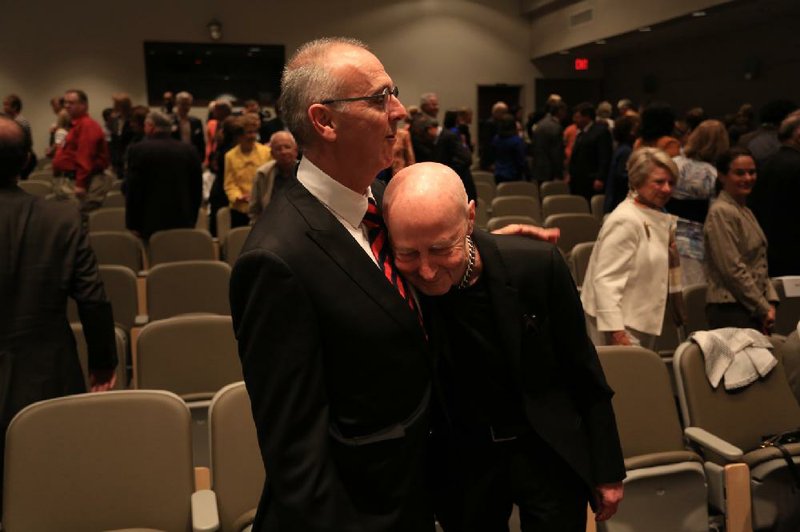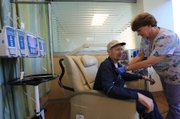A London doctor will serve as the new director of a world-renowned cancer center at the University of Arkansas for Medical Sciences, officials announced Tuesday.
Dr. Gareth Morgan, 57, will become the director of UAMS Medical Center’s Myeloma Institute for Research and Therapy on July 1.
The hospital plans to match Morgan’s current British salary of 500,000 pounds sterling, which is currently equivalent to about $841,000, UAMS spokesman Leslie Taylor said, adding that she didn’t know exactly how much of the salary would be publicly and privately funded and that the amount could change.
Morgan will replace Dr. Bart Barlogie, 69, who chose to step down from the leadership role after founding the institute some 25 years ago. The institute offers treatment to patients with multiple myeloma, a rare bone-marrow cancer.
Barlogie, who makes $428,910 annually, will continue to care for patients and research.
“I want to personally thank Bart for his dedication, his passion, his life’s work toward finding a cure for this disorder,” UAMS Chancellor Dr.Dan Rahn said. “It’s because of this overwhelming desire to take care of patients that today we pass the proverbial torch from one leader to another.”
Morgan, who is now a clinician and researcher at Myeloma UK Research Centre at the Institute of Cancer Research in London, holds more than $10 billion in grant funding and will bring with him a team of researchers to work with those currently at the institute, Rahn said.
It is unclear how many or which researchers he will bring.
“The work Dr. Morgan will do carries substantial promise of not only building research directions already being pursued within the institute, but in developing treatment with less toxicity, less costs and being less arduous on patients,” he said.
Sporting a suit, tie and gray tennis shoes, Morgan said he was looking forward to working at what he called the “world’s premier myeloma center.”
“It took a lot to drag me out of London,” he said in a later interview. “It’s a great opportunity for me. It’s an opportunity for the institution, but most of all, it’s an opportunity for the patients.”
Gov. Mike Beebe lauded the institute and what Barlogie had accomplished.
“You come to Little Rock, Ark., if you have a choice” if one has multiple myeloma, he said.
“Everybody can’t be No. 1 in everything, but when you can be No. 1 in something … it is a cause for celebration.”
Beebe said a group celebrated Morgan’s hire Monday night with a few drinks.
“And everybody looked happy,” he said. “And we’re still happy today.”
The crowd gave the governor a standing ovation as Beebe shook hands with Barlogie and Morgan afterward.
Beebe has committed $5 million in general improvement funds in a $1-to-$3 match. The institute’s advisory board was able to raise $15 million to get the matching state funds, officials said Tuesday. The money will be used for the construction of new laboratories and the institute’s research program, according to a news release.
The institute gets more than 450 new patients each year, 40 percent of whom come from out-of-state and from more than 50 foreign countries.
Years ago, one of those patients was the spouse of Carol Ammon, the chairman of the institute’s advisory board.
“My spouse was diagnosed back about six years ago with multiple myeloma,” she said. “And to me, it was my darkest day. It was a day of tremendous despair.”
After researching the disorder, Ammon came to Little Rock, and her spouse began receiving treatment from Barlogie.
Under Barlogie’s leadership, Rahn said the patient survival rate has “more than doubled” from three years to seven and beyond.
Since the institute was founded in 1989, it has also noted several “firsts,” including the first to conduct outpatient bone-marrow transplants, the first to use gene expression profiling to characterize patient risks and the first to receive a project grant from the National Cancer Institute, he said.
“As we convene here today, the goal of achieving a cure in multiple myeloma has been established,” Barlogie said. “And it’s happening in an ever-increasing fraction of patients.”
But Barlogie cautioned his fellow doctors and researchers to remember those patients who “are really hanging in there from a very thin thread.” Those are the ones for whom researchers work to find innovative approaches to target the myeloma, he said.
Morgan said the field is in a world of “targeted therapy” and that he plans to work on creating a series of clinical trials in attempts to find new treatments with minimal toxicity.
“With a common vision and shared philosophical approach, Dr. Morgan and I can infuse the myeloma program with a forward-moving emphasis on utilizing research and technology to benefit patients,” Barlogie said in a news release. “By bringing together our collective experience, we will be optimally poised to implement the latest scientific and treatment advances, while maintaining a focus on each individual patient.”
But that is just the start, Rahn said.
“We have a bolder, more ambitious view for the future.”
Front Section, Pages 1 on 04/23/2014

